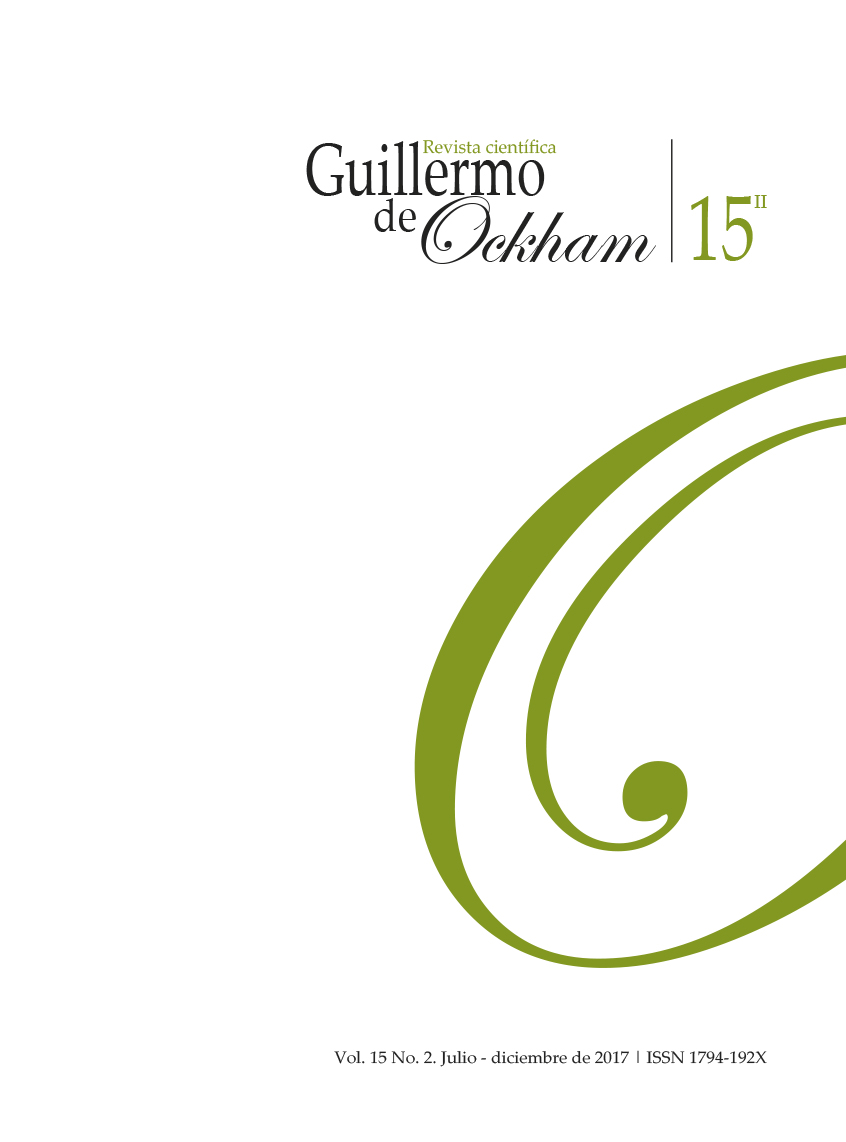The Revista Guillermo de Ockham provides an immediate and open access to its content, based on the principle of offering the public a free access to investigations to provide a global interchange of knowledge.
Unless otherwise established, the contents of this journal has a license with Creative Commons Attribution-NonCommercial-NoDerivatives 4.0 International (CC BY-NC-ND 4.0) http://creativecommons.org/licenses/by-nc-nd/4.0/
- Attribution: You must give appropriate credit, provide a link to the license, and indicate if changes were made. You may do so in any reasonable manner, but not in any way that suggests the licensor endorses you or your use.
- NonCommercial: You may not use the material for commercial purposes.
- NoDerivatives: If you remix, transform, or build upon the material, you may not distribute the modified material.
- No additional restrictions: You may not apply legal terms or technological measures that legally restrict others from doing anything the license permits.
Abstract
El factor de impacto (FI) es un indicador bibliométrico utilizado en la evaluación del impacto y visibilidad de las investigaciones diseminadas por las revistas científicas. Sin embargo, varios estudiosos han señalado críticas y limitaciones en cuanto a su utilización. Este trabajo objetiva comparar el FI de las revistas de América Latina, en el área de Ciencia Sociales, presentes simultáneamente en las bases de datos Scopus y Web of Science. Los resultados apuntaron que el 71% de las revistas presentaron los FIs calculados a partir de Scopus por encima de los obtenidos de la Web of Science. Se verificó la existencia de correlación lineal de Pearson de 0,43 de tendencia positiva y se aplicó la prueba Wilcoxon demostrando diferencias estadísticamente significativas entre los FIs (se utilizó el nivel de significancia del 5%). El estudio evidenció las dificultades de comparación del FI y de visibilidad internacional en la ciencia principal.
References
BOYLE F., SHERMAN D. (2006). Scopus: The product and its development. The Serials Librarian, 49, n. 3, p. 147-153.
CHADEGANI A. A., SALEHI H., YUNUS M. M., FARHADI H., FOOLADI M., FARHADI M., EBRAHIM N. A. (2013). A Comparison between Two Main Academic Literature Collections: Web of Science and Scopus Databases . Asian Social Science, V.9, n. 5.
CONOVER, W.J. (1998). Practical nonparametric statistics. New York: John Wiley & Sons.
GARFIELD, E.; SHER I. H. (1963). 1961 Science Citation Index. Philadelphia: Institute for Scientific Information, 2672 p.
GARFIELD, E. (1983). Mapping science in Third World. Science and Public Policy, June, p.112-127.
GARFIELD, E. (2005). The agony and the ecstasy – the history and meaning of Journal Impact Factor. In: INTERNATIONAL CONGRESS ON PEER REVIEW AND BIOMEDICAL PUBLICATON. Chicago.
GONZÁLEZ-MOLINA, A. y HERRERO-SOLANA, V. (2007). Coverage analysis of Scopus: a Journal metric approach. Scientometrics, vol. 73, no. 1, p.53–78.
GRACIO, M. C. C.; OLIVEIRA, E. F. T. (2014). Estudo comparativo teórico metodológico dos índices normalizados de citação: uma aplicação na ciência brasileira (1996-2007). Revista Em Questão, v.20, n. 3.
FERNANDÉZ-LLIMÓS, F. (2003). Análisis de la cobertura del concepto de Pharmaceutical Care en fuentes primarias y secundarias de información. Granada: Universidad de Granada.
GLÄNZEL W., MOED F. H. (2002). Journal impact measures in bibliometric research. Scientometrics.
GLÄNZEL, W. (2003). Bibliometrics as a research field: a course on theory and application of bibliometric indicators. [S.l.]: Coursehandouts.
KALTENBORN F. K. (2004). Validity and fairness of the impact factor. Birkhäuser.
LÓPEZ-PIÑERO, J.M.; TERRADA, M.L. (1992). Los indicadores bibliométricos y la evaluación de la actividad médico-científica. (III) Los indicadores de producción, circulación y dispersión, consumo de la información y repercusión. Medicina Clínica, n. 98, p. 142-148.
MARCHLEWSKI C., SILVA M. P., SORIANO B. J. A. (2011). Influência do sistema de avaliação Qualis na produção do conhecimento científico: algumas reflexões sobre a Educação Física. Motriz, Rio Claro, v. 17, n. 1, jan-mar., 2011.
MENEGHINI R. (2003). O projeto Scielo (Scientific Electronic Library on Line) e a visibilidade da literatura científica "Periférica". Química Nova, v. 26, n. 2, São Paulo.
MIGUEL S. (2011). Revistas y producción científica de América Latina y El Caribe: su visibilidad en SciELO, RedALyC y SCOPUS. Revista Interamericana de Bibliotecología, v. 34, n. 2, 187-199.
MOED, H. F., VAN LEEUWEN, T. N. & REEDIJK, J. (1998). A new classification system to describe the ageing of Scientific journals and their impact factors. Journal of Documentation, v. 54 (4), 387-419.
Moed, H. F.; van Leeuwen Th. N. (1996). Impact factors can mislead. Nature, may, v. 381, may.
SANCHO, R. (1992). Misjudgments and shortcomings in the measurement of scientific activities in less developed countries. Scientometrics, vol. 23, no. 1, p. 221-233.
SANTA, S., HERRERO-SOLANA V. (2010 ) Cobertura de la ciencia de América Latina y el Caribe en Scopus vs Web of Science. Revista Interamericana de Bibliotecología,, V. 24, n. 52, p. 13-27.
SEGLEN, P.O. (1997). Citations and journal impact factors: Questionable indicators of research quality. Allergy, v. 52 (11), p. 1050-1056, 1997.
SILVA R. M. (2010). Qualis 2011-20123 – os três erres. São Paulo: Clinics, v. 65, n. 10.
SIMONS K. (2008). The misused Impact Factor. Science, v. 322 (5899), n. 10.
SPINAK, E. (1998). Indicadores cienciométricos. Ciência da Informação, v. 27, n. 2, p. 141-148.
STUMPF I. R. C. (1998). Reflexões sobre as revistas brasileiras. Intexto. v.1, n.3, p. 1-10.
VELHO, Lea M. L.S. (1985). Como medir a Ciência? Revista brasileira de tecnologia. Brasília, jan/fev., v. 16, n.1, p.35-41.
































